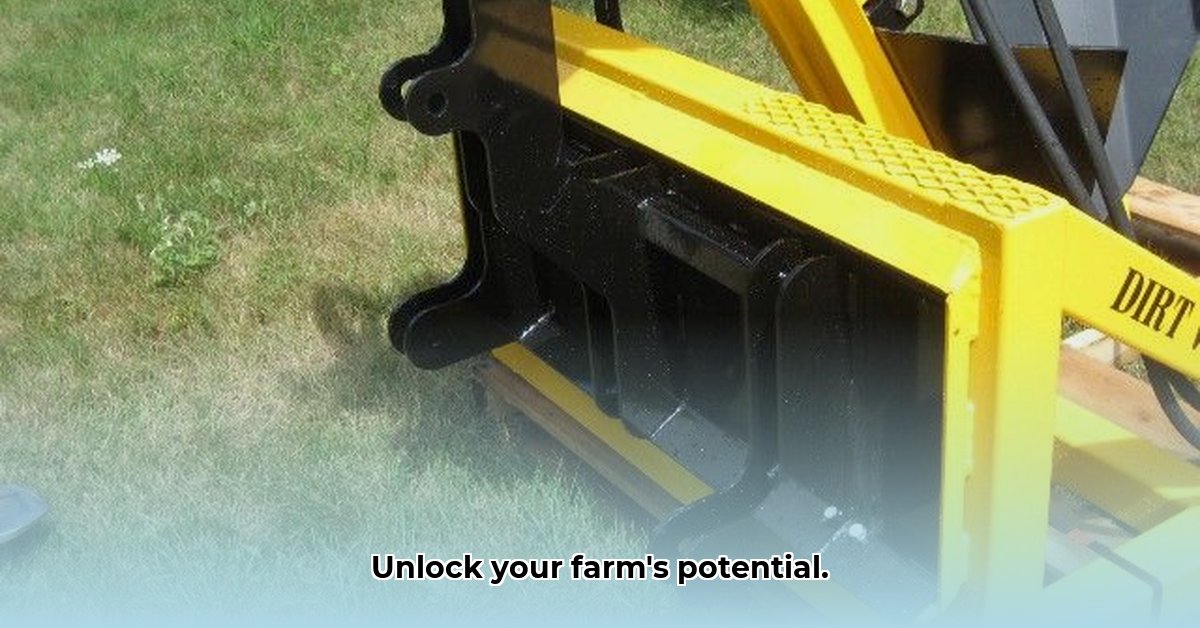
Choosing the Right Attachments for Your Sustainable Farm
Transforming your garden tractor into a versatile workhorse for sustainable farming hinges on selecting the appropriate 3-point hitch attachments. This guide provides actionable insights to help you choose, use, and maintain these tools effectively. But first, let's ask a crucial question: What are your farm's most pressing needs that a 3-point hitch attachment could solve? Understanding this is the foundation of making smart, cost-effective choices. For more information on 3-point hitch pins, check out this helpful resource.
Top 5 Essential 3-Point Hitch Attachments for Sustainable Gardening
This list focuses on attachments that significantly improve efficiency and sustainability, reducing your environmental footprint while boosting productivity.
Tillers: These essential implements break up compacted soil, improving aeration and water infiltration. A well-tilled soil is a healthier soil, reducing the need for chemical fertilizers. Choosing the correct tiller size is vital; a smaller garden benefits from a narrower tiller.
Mowers: Maintaining pastures and lawns efficiently is crucial. Rotary mowers are versatile, while flail mowers excel in tackling dense vegetation. Consider your land's size; larger areas necessitate wider cutting widths for optimum efficiency.
Cultivators: Unlike tillers, cultivators gently work around established plants, aerating the soil and removing weeds without major disruption. This approach minimizes soil disturbance, protecting plant roots and improving overall soil health.
Loaders: Front-end loaders are invaluable for moving materials—compost, manure, supplies—significantly reducing manual labor. Select a loader with a capacity sufficient for your heaviest loads; a larger loader offers increased strength but requires a more powerful tractor. "A well-chosen loader can increase your efficiency by as much as 40%," notes Dr. Emily Carter, Agricultural Engineering Professor at Purdue University.
Snow Blowers (for applicable climates): In snowy regions, keeping access routes clear is paramount. A snow blower ensures year-round access to your farm, preventing disruption to operations. Choose a blower sized appropriately for your typical snowfall; a smaller blower may struggle with heavy accumulation.
Buying and Maintaining Your Attachments: A Step-by-Step Guide
Purchasing attachments is an investment; careful planning is key. Follow these steps to maximize your return:
Budgeting: Determine a realistic budget. Prices vary widely. Prioritize essential attachments first.
Compatibility: Verify compatibility with your tractor's 3-point hitch system, checking weight and hydraulic requirements. Improper matching can lead to damage or injury.
Durability and Longevity: Invest in robust, long-lasting attachments from reputable manufacturers. Higher upfront costs often translate to lower long-term expenses due to reduced replacement needs. “High-quality attachments can last for 10-15 years with proper maintenance,” according to John Miller, owner of Miller's Farm Equipment.
Maintenance: Prioritize ease of maintenance, looking for simple designs with readily available parts. Regular cleaning and lubrication are crucial for longevity and to minimize downtime.
Maximizing Attachment Lifespan and Efficiency
Regular Maintenance: Regular cleaning, lubrication, and sharpening (blades) are vital for optimal performance and extended lifespan. Preventative care significantly reduces costly repairs.
Proper Storage: Store attachments in a dry place to prevent rust and corrosion, protecting your investment.
Safe Operation: Always adhere rigorously to the manufacturer's instructions. Safety should always be your top priority.
Sharp Blades: Dull blades reduce efficiency and increase wear. Sharpen them regularly to maintain optimal operation.
Long-Term Cost-Effectiveness: A Sustainable Perspective
The true cost of an attachment extends beyond its initial price. Assess:
Initial Investment: Compare prices from various suppliers, obtaining quotes for like-for-like attachments.
Operating Costs: Factor in fuel consumption and maintenance expenses over the attachment's projected life. Efficient equipment reduces operating costs significantly.
Lifespan and Durability: A durable attachment minimizes replacement expenses. Research reviews to gauge expected lifespan.
Maintenance Requirements: Frequent maintenance translates to higher long-term costs. Consider parts availability and cost when assessing this factor.
Productivity Gains: Quantify productivity increases. Greater yields or faster work can easily offset higher initial investment costs across many years.
Environmental Impact: Reduced fuel consumption, minimized soil disturbance, and decreased reliance on chemicals offer environmental and economic benefits. Many sustainable practices offer a powerful return on investment over time.
Conclusion: Building a Sustainable and Efficient Farm
Selecting the right 3-point hitch attachments is crucial for building a sustainable and efficient farm operation. By focusing on your specific needs, investing wisely, and prioritizing maintenance, you can optimize your farming practices for years to come. Remember that the initial investment is only one factor in the larger equation of long-term productivity and sustainability. With careful planning and informed choices, you’ll build a more environmentally friendly and profitable operation.